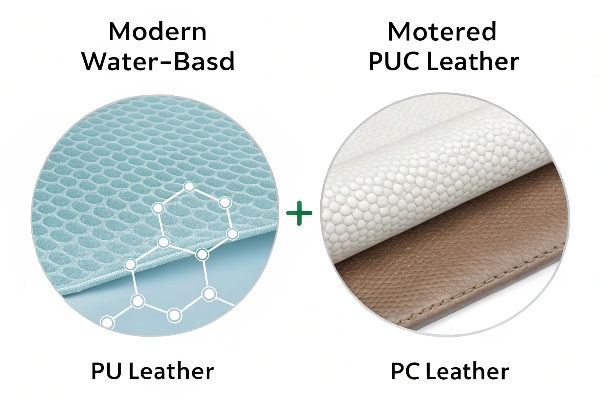The sofa looks great today, yet you are not sure which coating hides beneath the color. You fear picking the wrong faux leather and losing customers.
PU leather is made from a polyurethane coating on fabric, while PVC leather uses polyvinyl chloride with plasticizers. PU feels softer, breathes better, and ages like natural hide; PVC resists moisture, cleans fast, and costs less.

You now know the core split, but the real choice depends on use, price, and rules. Let’s break each question apart so you can order with calm and confidence.
Which is better, PU or PVC leather?
Your buyer presses you for a fast answer. You fear giving vague words and losing the deal. A clear frame will stop the doubt.
PU is better for comfort and eco goals; PVC is better for water-proofing and tight budgets. The “better” pick shifts with seat type, climate, and brand story.

Comfort, Cost, and Care Compared
I have tested both lines in my showroom. Here is how they rank in the three points most clients ask about.
| Factor | PU Leather | PVC Leather | My note from field work |
|---|---|---|---|
| Touch & Flex | Soft, warm, bends like hide | Firmer, can crack if over-folded | PU wins for fashion seats and bags. |
| Breathability | Micro pores let air flow | Near zero airflow | PU keeps seats cooler in summer. |
| Cleanability | Needs mild soap only | Wipes spotless with alcohol | PVC shines in hospitals and boats. |
| Price | Mid-range | Lowest of the two | PVC lifts margin in mass furniture lines. |
| Lifespan | 3-5 years heavy use | 4-7 years if kept indoors | Both last, yet PVC edges PU in dry zones. |
So, when a sofa brand wants a silky hand feel at a mid price, I guide them to PU. When a marine seat maker wants stain armor first, I ship PVC.
Is PVC better than PU?
A new project asks for flame test pass and sharp emboss detail. You wonder if PVC can hit both marks in one roll.
PVC beats PU for flame resistance, water lockout, and deep grain emboss. Its higher chloride content lets it self-extinguish, while its rigid base holds crisp textures.

When PVC Takes the Lead
Let me unpack real specs from a recent bus seat tender.
| Requirement | PU Result | PVC Result | Outcome in my tender |
|---|---|---|---|
| FMVSS 302 Flame Test | Needs extra FR add-ons | Passes base compound | PVC saved 0.30 USD per yard |
| Hydrostatic Water Column | 300 mm | 1,000 mm | PVC chosen for tropical routes |
| Deep Basket Weave Emboss | Soft edges flatten fast | Holds shape long | Client loved the bold grain on PVC |
Hence, for strict fire codes or wet zones, PVC often wins. I still add a low-VOC grade so smell stays mild.
Is PVC leather good quality?
A partner once told me, “PVC is cheap plastic, right?” That myth trips many orders. Let us break it down.
High-grade PVC leather can reach 250,000 double rubs, UV 5-grade, and 7-year indoor life. Quality rests on resin purity, stabilizers, and fabric backing, not on the PVC tag alone.

Keys to Spot Top-Tier PVC
I walk buyers through three checkpoints during factory visits.
| Checkpoint | What to Inspect | Good Sign | Red Flag |
|---|---|---|---|
| Odor on Warm Sample | Slight sweet, no sharp bite | Pass | Strong chlorine smell |
| Cold Crack Test (-20 °C) | Bend sample on itself | No white lines | Surface split |
| Backing Fabric | Tight polyester or cotton | Even weave, no loose yarn | Thin non-woven fuzz |
When these three pass, the PVC piece can outlast mid-grade PU on booths, headboards, and kids’ furniture. I still push suppliers to meet REACH and ISO 9001 so quality stays locked.
Is PU safer than PVC?
Parents ask if the kid’s chair emits toxins. You need a firm reply that shields your brand from health claims.
PU is safer in VOC and dioxin risk because it lacks chlorine. Modern water-based PU cuts solvent smell, while PVC can release phthalates if not chosen well.

Health and Planet Scorecard
Below is how I grade safety in my sourcing workbook.
| Safety Metric | PU Leather (Water-based) | PVC Leather (Low-VOCs) | My Advice |
|---|---|---|---|
| VOC Emission | <0.5 mg/m² h | 1-2 mg/m² h | PU leads for indoor air goals |
| Phthalate Content | Zero | Can be zero if DOTP used | Ask for phthalate-free PVC |
| End-of-Life Burning | CO₂, H₂O mainly | Risk of dioxin if burned openly | Push recycling or controlled incineration |
| Bio-based Options | Up to 25 % corn polyols | Emerging, still rare | PU offers clearer green story |
Thus, when a nursery brand calls, I steer them to water-based PU. Yet, for a stadium seat order, low-VOC PVC with DOTP plasticizer still meets safety norms at lower cost.
Conclusion
PU wins on comfort and safety; PVC wins on price and protection. Choose by end use, test results, and story you wish to tell.
